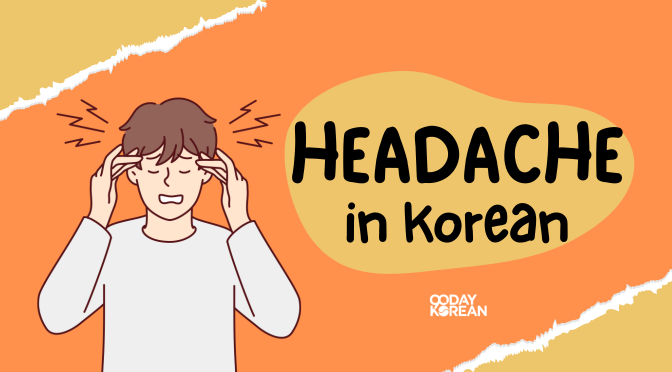Curious how to say “headache” in Korean?
It’s a common phrase that you’ll hear in K-Dramas, K-Pop songs, and in everyday life in Korea. It’s also quite valuable to know how to say, especially if you’re planning on visiting South Korea.
So today, we will show you what you need to know about how to say “headache” in Korean.
Below, we’ll explain how to express “headache” in Korean. We’ve written the Korean words you need to know in both Hangeul (Korean Alphabet) and Romanized English.
If you’re serious about learning Korean, then we definitely recommend spending the hour it takes to learn the Korean Alphabet. This step-by-step guide explains it all.
Contents
“Headache” in Korean
The correct word for saying “headache” in Korean is 두통 (dutong). This is the direct translation and medical term for “headache.”
“My head hurts” in Korean
However, in case you have trouble remembering the word, there is also another expression you can use. This expression is 머리가 아프다 (meoriga apheuda) in its basic form. In English, this translates to “my head hurts.”
You’ll be understood just fine by using this expression, but know that the word 두통 (dutong) is the more official one and the one you’ll likely impress others with by knowing.
저는 심한 두통을 앓아서 약을 필요해요. ( jeoneun simhan dutongeul araseo yageul piryohaeyo.)
I need medication for my severe headache.
두통이 심하면 약을 좀 먹어요. ( dutongi simhamyeon yageul jom meogeoyo.)
If your headache is severe, eat some medicine.
제 두통은 뭘 써도 나을 것 같지 않아서 도와주세요. (je dutongeun mwol sseodo naeul geot gatji anaseo dowajuseyo.)
Please help, nothing seems to be relieving my headache.
미안해, 머리가 아파서 우리 약속을 취소해야해. (mianhae, meoriga apaseo uri yaksogeul chwisohaeyahae.)
I’m sorry, I have to cancel our plans because my head hurts.
아이구, 지독한 두통이 보이나 봐. (aigu, jidokan dutongi boina bwa.)
Aigoo, looks like a vicious headache.
오늘 머리가 굉장히 아파. (oneul meoriga goengjanghi apa)
My head hurts severely today.
Associations for “Headache” in Korean
To remember the official word for headache, 두통 (dutong), just imagine you have a massive two-ton (두통 | dutong) weight on your head that is causing a massive headache.
To remember the expression 머리가 아프다 (meoriga apheuda) we first need to break it down:
아프다 – apheuda | hurt (to be painful)
For 머리가 (meoriga), we can use the story: “Our head gives us more rigor to get through the day.”
For 아프다 (apheuda), think of the Simpson’s TV character Apu. Whenever he introduces himself, Apu Da! Something bad happens to hurt him, and he yells Da!
So then we have the easy story: “Apu is introducing himself, but then he gets hit in the head! Ouch!” 머리가 아프다 (meoriga apheuda)
Here are some words about discomfort in other areas of the body.
편두통 (pyeondutong) – migraine
치통 (chitong) – toothache
위통 (witong) – stomachache
열 (yeol) – fever
인두통 (indutong) – sore throat
A word of caution about Romanization
While it is possible for you to study the words in this article simply by reading their Romanized versions, it will come in handy for you to be able to read Hangeul if you ever wish to come to Korea. Hangeul is the Korean alphabet, and not difficult to learn. In fact, you can learn it in just 90 minutes.
When you’re already familiar with Hangeul, life in South Korea will suddenly seem so much easier, and the country won’t appear so foreign for you. So, if you’re serious about learning Korean, why not learn Hangeul today?
Wrap Up
So now that you know how to say “headache” in Korean, you’ll have no problem telling the pharmacist what you need! What other words would you like to learn? Let us know in the comments below.
Photo Credit: BigStockPhoto





